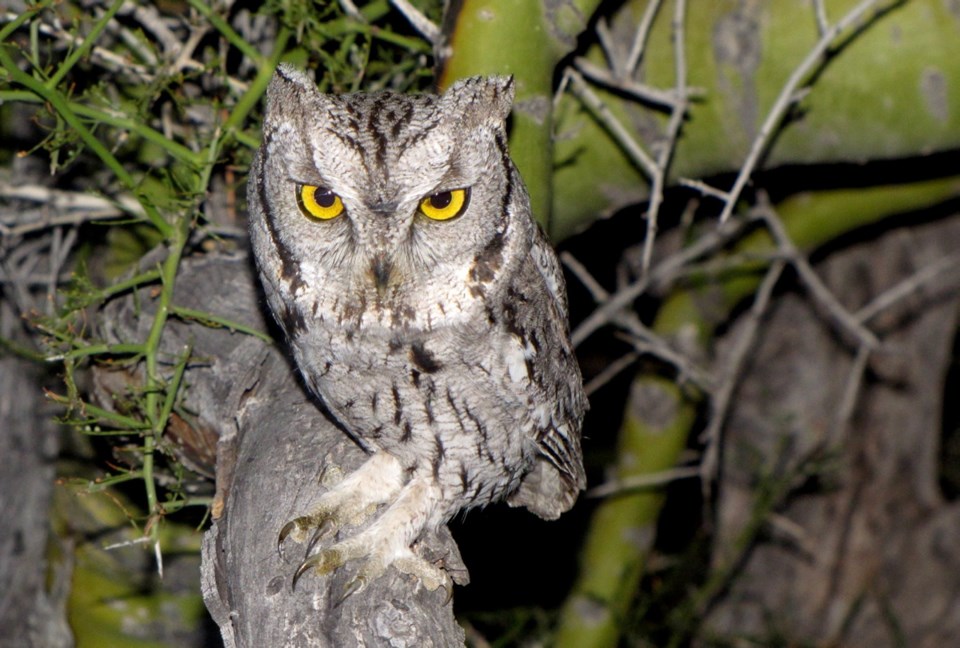Want to stay out late and have a hoot?
The Habitat Acquisition Trust would love your help monitoring mating calls of the endangered Western screech owl. On the night of Feb. 24, dozens of volunteers will drive to wooded areas around Greater Victoria at dusk and stay out late listening for the bouncing ball-whistling hoot of the Western screech owl.
“Since 2015, we’ve been going around the region doing surveys and listening for owls,” said Paige Erickson-McGee, a stewardship co-ordinator with the trust.
The Western screech owl population has declined 90 per cent over the past 10 years, said Erickson-McGee. She believes there are only 20 left in the capital region.
“In the mid-1990s, there used to be 10 breeding pairs at the University of Victoria. But within a really short period of time, we’ve seen a real decline, mostly due to loss of habitat and the introduction of barred owls,” she said.
Barred owls compete for food with the smaller Western screech owls, which are only seven to 10 inches in length. Western screech owls used to live in wetland areas and along creeks and around ponds, but the barred owls have invaded their habitat and pushed them out, said Erickson-McGee.
Logging also threatens the Western screech owls. Western screech owls stick to forested areas and need 50 hectares of land to survive, she said.
The owls nest in the cavities of dead trees, which have been hollowed out by woodpeckers.
“We call them secondary cavity nesters because they can’t make the hole themselves and rely on other species.”
To make up for the loss of habitat, the trust has been installing nest boxes which replicate the cavities, putting them up where the owls have been heard. Already, two of these boxes have become home to breeding owl pairs.
The trust has found five sites where Western screech owls have been heard.
The population of Western screech owls is at risk from cats and poisons used to kill rodents.
Mating season for Western screech owls is from February to April.
Volunteers will listen for their distinctive courtship calls in areas where the owls have lived in the past or been recently reported, said Erickson-McGee.
“We are looking for volunteers who want to come out in the dark and listen for owls along roads in the Highlands and Sooke, areas with lots of intact forest,” said Erickson-McGee.
People can also volunteer to listen in their own neighbourhoods.
It’s really important that people know a number of species are decreasing because of development, especially in the West Shore, she said.
“If we are to let these species decline, over time, we’ll not be left with very much. The Western screech owl is an important part of the ecosystem. They help control rodent populations.”
Western screech owls don’t actually screech, she said.
To hear their call, go to allaboutbirds.org/guide/Western_Screech-Owl/sounds.
People interested in helping with the listening survey can contact [email protected] or call 250-995-2428 to sign up. Carpooling is available and experience with birding is an asset, but not required.
About the Western screech owl
• The coastal Western screech owl (Megascops kennicottii kennicottii) is a small owl with yellow eyes and “horns” or “ear-tufts” — actually just feathers to help with camouflage — on its head. The call is a distinctive descending series of whistled “hoos.”
• The owl was formerly abundant throughout Greater Victoria. Due to habitat changes that have led to the establishment and growth of the barred owl population, the number of Western screech owls in Greater Victoria has declined by more than 90 per cent in the past 10 years.
• Today, Western screech owls are restricted to a few older forests, mostly in Highlands, and only a few pairs are known to be left.
— Source: Habitat Acquisition Trust



